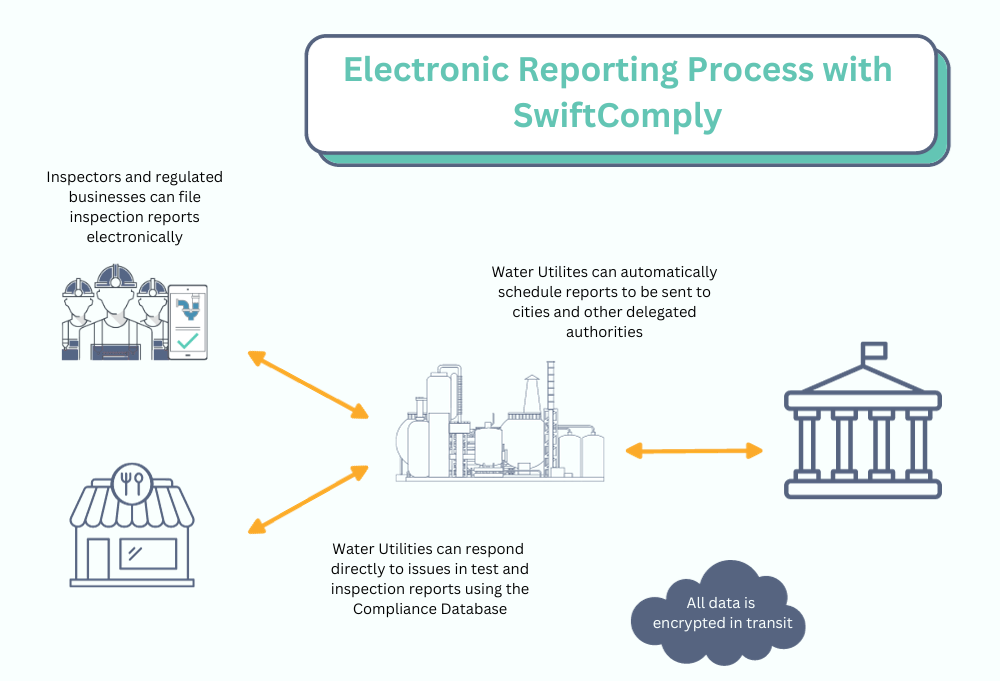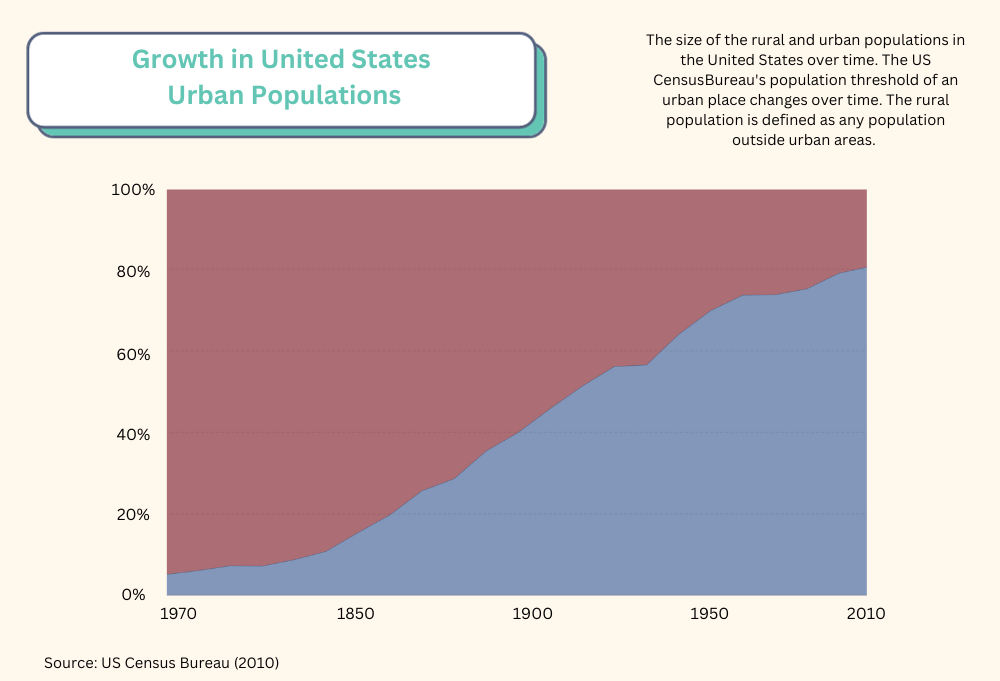Talking to our partners in water utilities about the challenges they face, a common one that prevails is a sense that the administrative side of compliance programs is more time-intensive than they’d like. Whether it’s Industrial Pretreatment, Backflow, or FOG Programs they’re responsible for, they all agree that the burden of compiling compliance reports often takes up more of their working week than they’d like.
While it may not be fun, the reality is that reporting is one of the core responsibilities of a Compliance Program Manager. But when we sit down and analyze our partner’s compliance reporting processes, we often identify it as the area most open to improvements in efficiency.
Below, we’ll take a look at what exactly Electronic Reporting involves for water utilities, and how it can be leveraged to make your compliance programs more effective. We’ll also discuss how SwiftComply’s compliance solutions play a role in transforming the reporting process for water programs.
Why is electronic reporting important for public water utilities?
Keeping public water safe is the name of the game for all water utilities. While the job can often be demanding and complex, maintaining a clean and safe water supply is what it’s all about.
The objective is simple, but water utilities have a lot of moving parts that require strict management. Like any process, there must be sufficient oversight and understanding of what impact their everyday activities have on their programs.
As important, however, is the oversight that regulatory authorities have over individual water compliance programs. For this to work effectively, water utilities are required to submit regular reports to their state highlighting key compliance-related metrics. This task is often seen as a bit of a burden by compliance managers, who believe that proactively identifying water hazards, the installation of control devices (backflow and cross-connection), or ensuring FSEs file their FOG inspection reports.
In truth, however, reporting on compliance is every bit as important as field inspections. It shines a light on non-compliance issues that arise over time and might otherwise be missed, and it ensures that public water utilities are adhering to the required standards set down by the EPA. Without these reports, there’s a risk that some programs might not be effective, and could miss critical non-compliance issues, and put public water at risk.
This is where Electronic Reporting becomes critical in the proper functioning of modern water utilities. Electronic Reporting, also known as eReporting refers to the process of submitting required reports, data, or documents in an electronic format. Electronic reporting has a number of distinct advantages over traditional, paper-based reporting which will be discussed below, and has been widely adopted by a majority of water utilities in the U.S. in recent decades.
Although it offers advantages over traditional reporting, it is stringently regulated and governed in the water and wastewater sectors. This is true of almost every public institution that collects public data, but with critical infrastructure and resources such as water, there is a focus on ensuring that the transfer of data adheres to the strictest of security protocols.
Below, we’ve outlined 5 reasons you should be considering electronic reporting for your utility.
Top 5 Reasons to Adopt Electronic Reporting
1. Efficiency
The need to do more with less has become a well-documented trend for water utilities right across the United States. This trend is a result of 2 key factors – a retirement wave of water and wastewater officials, and steadily growing urban populations.
These factors have increased the administrative burden that Compliance Managers and dedicated administrative staff have found themselves struggling with the increased workload. In particular, increasing urban populations in the United States has resulted in more data to process and has increased the amount of time required to compile reports.
The good news is that electronic reporting is well-positioned to address both these issues. On the data entry side of things, electronic inspection reports benefit by capturing data in real-time by inspectors in the field and automatically storing it on a centralized database without the need for manual data entry.
On top of eliminating countless hours of manual data entry, modern compliance solutions are also equipped to compile reports based on pre-defined parameters and automate the reporting process set down by your state authority.
While legacy solutions like Microsoft Excel have certainly played a big part in how utilities compile reports over recent decades, modern compliance solutions are more agile and more capable of collating and presenting data automatically without the need for hours of spreadsheet work.
2. Data Accessibility & Accuracy
Modern compliance solutions have changed the way we collect compliance data for the better, but the accuracy and instant accessibility of key insights have been transformative.
The reality of compiling reports on solutions like Excel is that no matter how much due care and attention you give it, you’re likely to make small errors in your data entry process. Even with the best review and data validation processes, small inaccuracies or omissions are inevitable. eReporting solutions are designed to identify such issues at the source (for example, a missing field in an inspection report) and prompt users to rectify it at source. It also deals with small anomalies as they occur, prompting manual review before submission.
The result of providing clean, accurate data to your state authority, is a significant reduction in the amount of time spent on back-and-forth communication, allowing more time for you to focus on proactive compliance activities.
3. Data Security
As we already mentioned, IT security and data protection have become a core focus for every level of government in recent years. With cyber-attacks becoming more prevalent in the water utility sector, how reports are transferred between water utilities, local governments, state governments, and the EPA is now in sharp focus.
In the past, attaching reports to emails as PDFs or spreadsheets was sufficient, but that will no longer be permitted for utilities under NPDES reporting regulations and CROMERR rules. The advantage of electronic reporting through secure systems is that you have a much greater degree of control and enhanced security. On the control side of things, they can be configured to provide access only to authorized individuals. This means that sensitive data can be shielded from unauthorized access, reducing the risk of data breaches. On data security, they employ encryption and other security measures to protect data during transmission. This is vital in preventing unauthorized access, interception, or tampering with sensitive information.
While there isn’t the scope in this blog to cover all of the advantages electronic reporting offers in terms of data security, the fact is that the solutions built in recent years have placed security at their core, unlike older solutions like email and file transfer tools.
4. Operational Continuity
While compiling compliance reports manually has served us well and still is a worthwhile skill, the time commitment required is no longer feasible for utilities.
The water and wastewater workforce is currently in transition, and attracting and retaining staff has been an ongoing struggle across the US. This has highlighted the need to bring new hires up to speed as quickly as possible, and the future of public water is entirely dependent on it.
Compiling reports manually helped many compliance managers become proficient in the basics of data analysis and Microsoft Excel, but the time required to do so is no longer something utilities can afford. Add to that the advancements in automation and artificial intelligence in recent years, and these skills and solutions are likely to become less relevant for administrative or managerial roles in utilities as reporting solutions become more user-friendly.
The automated nature of electronic reporting reduces the pressure from the loss of key skills in a more transitory workforce. There’s also the benefit of having electronic reporting solutions designed specifically for compliance programs, requiring fewer workarounds and customization to create the desired report parameters.
5. Scalability
As urban populations have trended upward across North America over the past decade, the pressures on water utilities have followed suit.
Although not unique to utilities, the level at which the workload scales with larger populations has been particularly pronounced. There is a direct correlation between this increased population and the amount of work that’s required for compliance programs – more people, means more water infrastructure, which means more inspections, and thus, more reporting.
This has added to the pressure of retirements within utilities. Still, it has also meant that forecasting growth and being able to handle it is now one of the key considerations for utility planning, one of the most important factors in determining the ability to safeguard our water.
With much of the analysis and compilation being done through automation in eReporting solutions, increases in the population don’t necessarily increase the administrative burden on compliance managers. Maintaining current reporting times allows utilities to enhance compliance through more proactive enforcement.
How SwiftComply takes the thinking out of electronic reporting
So, the reasons for adopting electronic reporting might be clear, but with increased regulation around how it’s done, it might be difficult to know where to start.
One way to approach any digital transformation within a water utility is to audit your current reporting process in line with the regulations that apply to your utility (e.g. CROMERR, NPDES eReporting, NetDMR, etc.). By learning and understanding the requirements of your utility when it comes to reporting, it will allow you to identify what you’re already doing right, and what you need to rectify to become compliant with the various rules and regulations.
At SwiftComply, one of the core functions of our water compliance systems is ensuring that electronic reporting is as simple and secure as it can be for utility managers. We do this by putting it at the center of everything we do. As a result, we have developed a Compliance Dashboard that makes visualizing, analyzing, and reporting a simple, fast, and accurate process.
We also have a team of compliance experts on hand who have experience in helping all types of water utilities transform the reporting processes.


